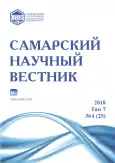Patterns in grassland vegetation of Bredinskiy state natural wildlife preserve
- Authors: Nazarenko N.N.1, Perlov Y.D.1
-
Affiliations:
- South Ural State Humanitarian Pedagogical University
- Issue: Vol 7, No 4 (2018)
- Pages: 85-93
- Section: 03.02.00 – General Biology
- URL: https://journals.rcsi.science/2309-4370/article/view/21857
- DOI: https://doi.org/10.17816/snv201874115
- ID: 21857
Cite item
Full Text
Abstract
The patterns (mosaicity) in grassland vegetation of Southern Ural for Bredinskiy state natural wildlife preserve example have been characterized by a hierarchical continuum concept theory. The multispecies patterns identification has been done by blocks and principal components methods and hierarchical patterns evaluation – by multivariate statistics (Cluster, Discriminant Analysis and Non-Metric Multidimensional Scaling) and biotopes phytoindication. It has been established that there are two patterns levels – parcels (6,0 m) and coenotics (11,0 m) in grassland vegetation. Thus, hierarchical continuum in steppe grassland vegetation of Southern Ural has been confirmed by multivariate statistics. Detected patterns have been classified and its phytochorologic unit has been identified. For patterns informative and dominant species have been also detected. It has been demonstrated that species dominance and its significance in patterns depend upon mosaicity levels. Some non-uniformly scaled ecological factors have been identified for patterns continuum. The principal significance for steppe grassland parcels matter coenotic and phytodiversity factors, for coenotics patterns forming matter abiotic factors too. For Bredinskiy state natural wildlife preserve principal abiotic factors steppe grassland patterns forming are (by decrease) soil calcium regime, soil nitrogen regime, soil acidity, soil mineralization and aeration.
Full Text
##article.viewOnOriginalSite##About the authors
Nazar Nikolayevich Nazarenko
South Ural State Humanitarian Pedagogical University
Email: nnazarenko@hotmail.com
doctor of biological sciences, professor of Chemistry, Ecology and Chemistry Methodology Department
Russian Federation, ChelyabinskYevgeny Dmitrievich Perlov
South Ural State Humanitarian Pedagogical University
Author for correspondence.
Email: jonp@mail.ru
student of Natural Sciences and Technologies Faculty
Russian Federation, ChelyabinskReferences
- Austin M.P., Smith T.M. A new model for the continuum concept // Vegetatio. 1989. Vol. 83, № 1-2. P. 35-47.
- Collins S.L., Glenn S.M., Roberts D.W. The hierarchical continuum concept // Journal of Vegetation Science. 1993. Vol. 4, is. 2. P. 149-156.
- O’Neil R.V., de Anders D.L., Waide J.B., Allen T.F.H. A hierarchical concept of ecosystems. Princeton, New Jersy: Princeton University Press, 1986. 153 p.
- Van der Maarel E. Pattern and process in plant community: fifty years after A.S. Watt // Journal of Vegetation Science. 1996. Vol. 7, is. 1. P. 19-28.
- Collins S.L., Glenn S.M., A hierarchical analysis of species abundance patterns in grassland vegetation // American Naturalist. 1990. № 135 (5). P. 633-648.
- Martinez K.A., Gibson D.J., Middleton B.A. Core-satellite species hypothesis and native versus exotic species in secondary succession // Plant Ecology. 2015. № 216 (3). P. 419-427.
- Заугольнова Л.Б. Иерархический подход к анализу лесной растительности малого речного бассейна (на примере Приокско-террасного заповедника) // Ботанический журнал. 1999. Т. 84, № 8. С. 42-56.
- Заугольнова Л.Б., Истомина И.И., Тихонова Е.В. Анализ растительного покрова лесной катены в антропогенном ландшафте (на примере бассейна р. Жилетовки, Подольский район Московской области) // Бюллетень МОИП. Отдел биологический. 2000. Т. 105, вып. 4. С. 42-52.
- Маслов А.А. Количественный анализ горизонтальной структуры лесных сообществ. М.: Наука, 1990. 160 с.
- Уланова Н.Г., Маслов А.А. Многомерный анализ горизонтальной структуры растительности вырубки // Ботанический журнал. 1989. Т. 74, № 9. С. 1316-1323.
- Рязанова Л.В. Конспект флоры степного юга Челябинской области. Челябинск: ЧГПУ, 2006. 445 с.
- Куликов П.В. Конспект флоры Челябинской области (сосудистые растения). Екатеринбург-Миасс: Геотур, 2005. 537 с.
- Маслов А.А. О совместном применении метода блоков и метода главных компонент для анализа мозаичности лесных сообществ. 1. Выделение осей // Бюллетень МОИП. Отд. Биологический. 1983. Т. 88, вып. 6. С. 73-79.
- Маслов А.А. О совместном применении метода блоков и метода главных компонент для анализа мозаичности лесных сообществ. 2. Идентификация осей экологическими факторами // Бюллетень МОИП. Отд. Биологический. 1985. Т. 90, вып. 4. С. 107-117.
- Xiaobing Dai, van der Maarel E. Transect-based patch size frequency analysis // Journal of Vegetation Science. 1997. Vol. 8, is. 6. P. 865-872.
- Смирнова О.В. Объем счетной единицы при изучении ценопопуляций растений различных биоморф // Ценопопуляции растений (Основные понятия и структура). М.: Наука, 1976. С. 72-80.
- Смирнова О.В. Структура травяного покрова широколиственных лесов. М.: Наука, 1987. 208 с.
- Анализ данных в экологии сообществ и ландшафтов / пер. с англ.; под ред. А.Н. Гельфана, Н.М. Новиковой, М.Б. Шадриной. М.: РАСХН, 1999. 306 с.
- Ханина Л.Г., Смирнов В.Э., Бобровский М.В. Новый метод анализа лесной растительности с использованием многомерной статистики (на примере заповедника Калужские засеки) // Бюллетень МОИП. Отд. биологический. 2002. Т. 107, вып. 1. С. 40-47.
- Legendre L., Legendre P. Numerical ecology. Amsterdam: Elsevier Science B.V., 1998. 853 p.
- McCune B., Grace J.B. Analysis of Ecological Communities. MjM SoftWare Design, 2002. 300 p.
- McLachlan G.J. Discriminant analysis and statistical pattern recognition. Wiley-Interscience: Hoboken, 2004. 580 p.
- Persson S. Ecological indicator values as an aid in the interpretation of ordination diagrams // Journal of Ecology. 1981. Vol. 69, № 1. P. 71-84.
- Didukh Ya.P. The ecological scales for the species of Ukrainian flora and their use in synphytoindication. Kiev: Phytosociocentre, 2011. 176 p.
- Маслов А.А. К оценке параметров экологических ниш лесных растений при помощи индикационных шкал // Перспективы теории фитоценологии. Тарту: Изд. АН ЭССР, 1988. С. 105-110.
Supplementary files











